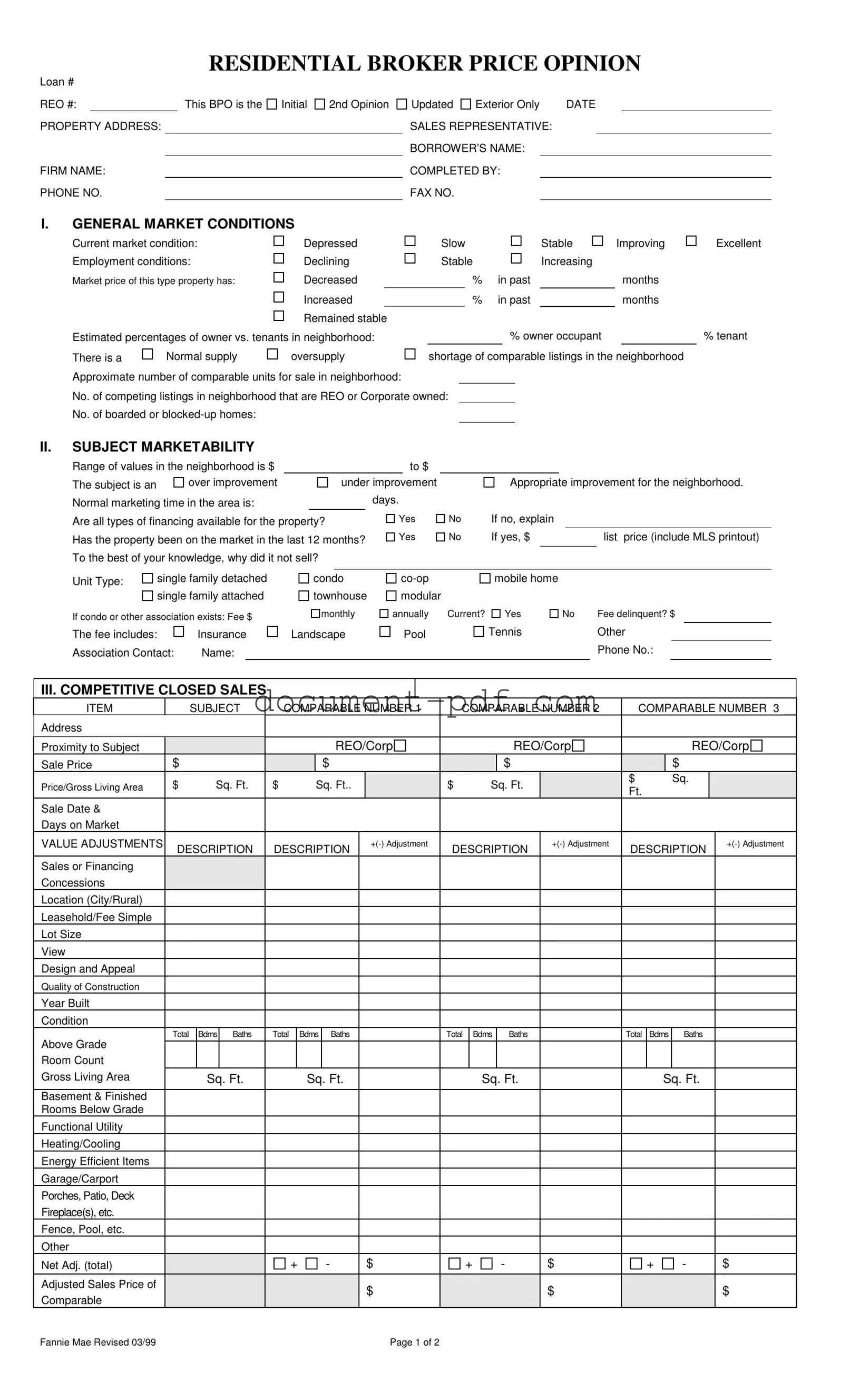The Broker Price Opinion (BPO) form shares similarities with the Comparative Market Analysis (CMA). Both documents assess the value of a property by examining comparable properties in the area. A CMA typically includes a detailed analysis of recently sold properties, active listings, and expired listings, providing a broader market perspective. While a BPO is often used by lenders and banks for quick valuations, a CMA is more commonly utilized by real estate agents to establish a competitive listing price for sellers. The CMA, therefore, tends to be more comprehensive in its analysis of market trends and conditions.
Another document akin to the BPO is the Appraisal Report. An appraisal is a formal assessment conducted by a licensed appraiser, which provides a detailed and legally binding opinion of a property's value. Like a BPO, an appraisal considers comparable sales, but it also includes a more extensive examination of the property’s condition, location, and unique features. Appraisals are often required for mortgage financing, making them a crucial component in real estate transactions, whereas BPOs are typically used for internal assessments by financial institutions.
The Property Condition Report (PCR) is another document that bears resemblance to the BPO. A PCR focuses specifically on the physical condition of a property, detailing any repairs needed and assessing its overall livability. While the BPO evaluates market value based on comparable sales, the PCR provides insight into the property’s state, which can influence its marketability. Both documents serve important roles in the buying and selling process, but they emphasize different aspects of property evaluation.
The Listing Agreement is also similar to the BPO in that it involves a property’s valuation. This document is a contract between a seller and a real estate agent, authorizing the agent to sell the property at a specified price. The listing agreement often references a BPO or CMA to justify the proposed listing price. While the BPO provides a snapshot of market conditions and property value, the listing agreement formalizes the relationship between the seller and the agent, setting the stage for the sales process.
Understanding the various documents involved in real estate transactions is crucial for both buyers and sellers. Among these, the Texas Power of Attorney form holds significant importance as it allows individuals to appoint someone to make critical decisions on their behalf, ensuring their interests are protected. For those interested in finding a reliable template for this essential document, resources such as texasformsonline.com/free-power-of-attorney-template/ can be invaluable in navigating the legal requirements.
The Seller’s Disclosure Statement shares similarities with the BPO as well. This document requires sellers to disclose known issues with the property, such as structural defects or zoning issues. While the BPO assesses market value based on external factors and comparable sales, the seller’s disclosure focuses on the internal aspects of the property that could affect its value. Both documents are essential for buyers to make informed decisions, highlighting the importance of transparency in real estate transactions.
The Lease Agreement is another document that can be compared to the BPO. While a BPO evaluates the sale price of a property, a lease agreement outlines the terms under which a property is rented. Both documents reflect the property's value, albeit from different perspectives. A lease agreement can provide insight into the rental market in a particular area, which can be useful when assessing the value of a property for sale. Understanding rental trends can help sellers and buyers alike gauge the potential income from a property.
Lastly, the Title Report is comparable to the BPO in that it provides critical information about a property’s ownership and any encumbrances that may exist. While the BPO focuses on market value, the title report reveals legal aspects that could impact the property’s sale. Both documents are essential in the real estate transaction process, ensuring that buyers are fully aware of any issues that could affect their investment.




 Unknown
Unknown
 Investor
Investor